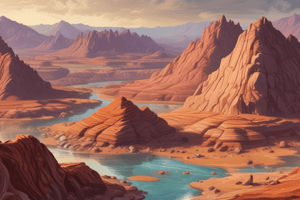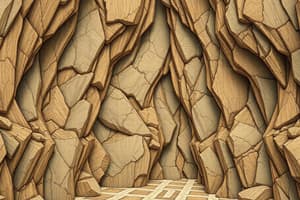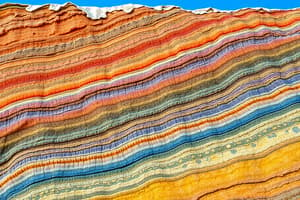Podcast
Questions and Answers
What does the size of particles in a detrital rock indicate?
What does the size of particles in a detrital rock indicate?
- The chemical makeup of the rock
- The mineral composition of the rock
- The transport distance from the source (correct)
- The age of the rock
Which of the following describes organic limestone?
Which of the following describes organic limestone?
- Forms through the precipitation of calcite from water
- Contains no fossil fragments
- Is composed primarily of calcite from biological sources (correct)
- Is derived from inorganic processes like hot springs
What type of limestone forms when calcite precipitates from water?
What type of limestone forms when calcite precipitates from water?
- Inorganic limestone (correct)
- Fossiliferous limestone
- Organically derived limestone
- Dolostone
What occurs to limestone during the formation of dolostone?
What occurs to limestone during the formation of dolostone?
What process leads to the formation of biochemical chert?
What process leads to the formation of biochemical chert?
Which of these is an example of replacement chert?
Which of these is an example of replacement chert?
Which rock type forms primarily from the precipitation of carbonate when CO2 bubbles out of groundwater?
Which rock type forms primarily from the precipitation of carbonate when CO2 bubbles out of groundwater?
What is the primary mineral composition of chert?
What is the primary mineral composition of chert?
What is the process of transforming loose sediments into solid rock called?
What is the process of transforming loose sediments into solid rock called?
Which characteristic is NOT used to classify clasts in sedimentary rocks?
Which characteristic is NOT used to classify clasts in sedimentary rocks?
What is the primary composition of sandstone?
What is the primary composition of sandstone?
Which sedimentary rock type is composed of sediments transported as solid particles?
Which sedimentary rock type is composed of sediments transported as solid particles?
What type of cement fills the spaces between grains in sedimentary rocks?
What type of cement fills the spaces between grains in sedimentary rocks?
What is the difference between conglomerate and breccia?
What is the difference between conglomerate and breccia?
Which of the following processes involves the wearing away of rock?
Which of the following processes involves the wearing away of rock?
What occurs during lithification that leads to a reduction in porosity?
What occurs during lithification that leads to a reduction in porosity?
What is the primary factor that triggers the deposition of evaporite rocks?
What is the primary factor that triggers the deposition of evaporite rocks?
Which stage does lignite represent in the formation of coal?
Which stage does lignite represent in the formation of coal?
What type of sedimentary environment is characterized by wind deposits, such as sand dunes?
What type of sedimentary environment is characterized by wind deposits, such as sand dunes?
Where are marine deep deposits typically found?
Where are marine deep deposits typically found?
What type of sedimentary basin is formed by extensional tectonics at divergent plate boundaries?
What type of sedimentary basin is formed by extensional tectonics at divergent plate boundaries?
Which sedimentary environment is characterized by deposits of calcite sand and mud?
Which sedimentary environment is characterized by deposits of calcite sand and mud?
What primarily characterizes delta environments?
What primarily characterizes delta environments?
Which of the following statements is true regarding sedimentary basins?
Which of the following statements is true regarding sedimentary basins?
What phenomenon causes the shoreline to migrate inland in sedimentary basins?
What phenomenon causes the shoreline to migrate inland in sedimentary basins?
What primarily contributes to the formation of passive margin basins?
What primarily contributes to the formation of passive margin basins?
Which sedimentary structure is formed perpendicular to the direction of current flow?
Which sedimentary structure is formed perpendicular to the direction of current flow?
What is the process that causes grading in graded bedding?
What is the process that causes grading in graded bedding?
How do mud cracks form on the surface of sedimentary layers?
How do mud cracks form on the surface of sedimentary layers?
What distinguishes cross-bedding from other sedimentary structures?
What distinguishes cross-bedding from other sedimentary structures?
What type of basin develops far from tectonic activity and is characterized by subsidence?
What type of basin develops far from tectonic activity and is characterized by subsidence?
What sedimentary structure typically indicates deposition in a current?
What sedimentary structure typically indicates deposition in a current?
Flashcards are hidden until you start studying
Study Notes
Sedimentary Rocks
- Sedimentary rocks are formed by the mechanical and chemical weathering of pre-existing rocks.
- They cover underlying metamorphic basement rocks.
From Sediment to Rock
- Weathering breaks down bedrock into grains and sediments.
- Erosion involves processes like abrasion, falling, and plucking, transporting these sediments.
- Transportation is carried out by gravity, wind, water, and ice.
- Deposition occurs when sediments settle out of the transporting medium.
- Diagenesis and lithification transform loose sediments into solid rock.
Lithification
- Lithification involves two main processes: compaction and cementation.
- Compaction is caused by the pressure of overlying sediments.
- Cementation occurs when minerals precipitate from water and fill the spaces between grains. Common cements include calcite, silica, and iron oxide.
Diagenesis
- Diagenesis refers to chemical, physical, and biological changes that occur after sediments are deposited.
Effects of Diagenesis
- Diagenesis results in:
- Grains being squeezed together.
- Reduction in porosity.
- Cementation.
Classifying Sedimentary Rocks
-
Texture:
- Clastic: Grains are stuck together by cement.
- Nonclastic: Have a pattern of interlocking crystals.
-
Sediment Transport:
- Detrital rocks: Sediment transported as solid particles. They have a clastic texture.
- Chemical rocks: Sediment once in solution.
Common Detrital Rocks
- Shale:
- Composed of mud-sized particles.
- The most common sedimentary rock.
- Sandstone:
- Composed of sand-sized particles.
- Dominated by quartz.
- Conglomerate & Breccia:
- Particles larger than 2mm in diameter.
- Conglomerate has rounded particles.
- Breccia has angular particles.
Clast Characteristics
- Clast size (diameter of fragments).
- Clast composition (mineral grains).
- Angularity (Smooth or angular corners?).
- Sphericity (shape of a clast; resemblance to a sphere).
- Sorting (clast’s size in a rock; same size or variety of sizes?).
- Character of cement (quartz or calcite?).
Transport Distance
- The size and rounding of particles in a detrital rock indicate the distance they have been transported.
- Closer to the source, particles are larger and more angular.
- Farther from the source, particles are smaller and more rounded.
Common Chemical Rocks
- Limestone:
- Composed of calcite (CaCO3).
- Organic limestone: Forms from reefs (coral), broken shells (coquina), and chalk (microorganisms/plankton shells).
- Inorganic limestone: Formed by the precipitation of CaCO3 from water. Examples include travertine and oolitic limestone.
- Dolostone:
- Formed from limestone (CaCO3).
- Calcite is replaced by the dolomite mineral (CaMgCO3)2.
- Chert:
- Biochemical: Made from microcrystalline quartz. Formed from the shells of silica-secreting plankton.
- Chemical:
- Replacement Chert: Quartz/silica replaces calcite in limestone.
- Petrified wood: Silica precipitates as quartz within a wood, replacing cellulose.
- Agate: Rock cavity filled by siliceous matter.
- Evaporite:
- Formed by the evaporation of water, causing the precipitation of minerals.
- Examples include rock salt and rock gypsum.
- Coal:
- Organic origin.
- Black combustible rock.
- Primarily composed of carbon (50-90%) with other elements like oxygen, nitrogen, hydrogen, sulfur, and silica.
- Various stages of coal formation:
- Plant material.
- Peat (partially altered plant material).
- Lignite.
- Bituminous.
Sedimentary Environments
- Continental Environments:
- Glacial deposits: Glaciers move sediment of any size, forming till.
- Mountain stream deposits: Dominated by turbulent stream erosion and deposition in mountain valleys.
- Alluvial fan deposits: Found in arid regions, where water streams deposit sediments, forming a wedge-shaped alluvial fan.
- Wind (Aolian) deposits: Ex: Sand dunes.
- River, Lake
- Marine Environments:
- Shallow marine deposits: Up to ~200 meters deep.
- Deep marine deposits: Seaward of continental shelves.
- Transitional Sedimentary Environments (Shoreline):
- Tidal flats: Flat coastal areas exposed and covered by tides. Deposits are mostly muddy.
- Lagoons: Protected bodies of quiet water. Deposits include calcite mud and calcite sand.
- Deltas: Where rivers empty into the sea.
Sedimentary Basins
- Basins are places where sediments accumulate.
- They form where the Earth's lithosphere sinks.
- Types of basins:
- Rift basins: Formed at divergent (pull-apart) plate boundaries.
- Intercontinental basins: Initially rift zones, but later form in interiors, far from plate margins.
- Foreland basins: Form when the lithosphere flexes in response to thickened crust caused by plate collisions.
- Passive margin basins: Formed along the edges of continents, far from active plate boundaries.
Transgression & Regression
- Transgression: Sea level rise leads to the shore migrating inland.
- Regression: Sea level fall leads to the shore migrating seaward.
Sedimentary Structures
-
Sedimentary structures are layering patterns in sedimentary rocks.
-
They provide clues about the environment in which the sediments were deposited.
-
Types of sedimentary structures:
- Ripple marks: Elongated ridges formed on a bed, perpendicular to the direction of current flow.
- Dunes (mega ripples): Large, elongated ridges, tens of centimeters high.
- Bedding planes: Boundaries between beds.
- Cross-bedding: Inclined curving surfaces/laminations in ripples or dunes, formed as sediment moves up the gentle side of a ripple or dune and then slides down the steep face.
- Graded bedding: Fine grain at the top, coarse at the bottom, caused by turbidity currents.
- Mud cracks: Bed surface markings formed when mud dries and contracts.
Studying That Suits You
Use AI to generate personalized quizzes and flashcards to suit your learning preferences.




